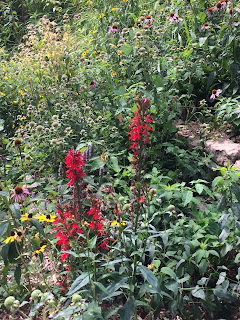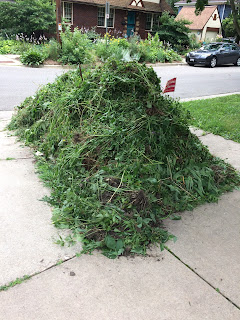The falling leaves on my walk also reminded me of Wendell Berry's poem about Autumn titled "October 10."
Now constantly there is the sound,
quieter than rain, of the leaves
falling.
Under their loosening bright
gold, the sycamore limbs
bleach whiter.
Now the only flowers are
beeweed and aster, spray
of their white and lavender
over the brown leaves.
The calling of a crow sounds
loud —a landmark— now that the life of summer falls
silent, and the nights grow.
We had a preview of winter during the October 20th UW Homecoming game. For about 45 minutes, large snow flakes and strong winds pelted Madison and UW fans. My brother Lou, his wife, Corine, Les, and his friend, Eunice cut short their attendance at Camp Randall. I picked them up at half-time after Corine called me. Her thick fur coat failed to provide protection from the dampness and piercing wind. We continued our 32th Homecoming celebration, along with Gary and his wife, Kathy in our comfortable and warm apartment. Gary, Kathy, Ann and I did not attend the game.
Gary, Les, Lou and I are UW Alumni. Gary, Kathy, and Les are my legacy friends with deep connections spanning more than fifty years. Les and I met as 7th graders, attended the same high school, and were roommates during our junior and senior years at UW Madison.
Gary and I met during our Freshman year at Pulaski High School. He also, along with Les, was a college roommate. I had a role in introducing Gary and Kathy more than fifty years ago and I was in their wedding party.
Gary, Les and I also commuted from our homes near Pulaski to the then two year UW-Madison Green Bay Center during the mid-1960s. We transferred to UW Madison after completing our sophomore year. Listening to and singing along with the newly minted Beatles on the local radio station while traveling down snowy Highway 29 is just one of many fond memories. Another is my first trip in the Fall of 1964 to UW Madison with Les in his 1957 green Chevy. In retrospect, I realize how that trip marked a major transition in our lives. Our lives would never be the same.
Now decades later I enjoy community gardening with my neighbors. On Saturday, October 13th, ten neighbors besides Ann and I, enjoyed each others company, while finishing preparing the Prospect Gardens for the winter. Pictured below are Loren, me, Eli, Laura, Joyce (behind Eli), Ann N., Percy and Ken in the back row. Gary and his wife, Patty and Laima arrived after the picture was taken.
Now decades later I enjoy community gardening with my neighbors. On Saturday, October 13th, ten neighbors besides Ann and I, enjoyed each others company, while finishing preparing the Prospect Gardens for the winter. Pictured below are Loren, me, Eli, Laura, Joyce (behind Eli), Ann N., Percy and Ken in the back row. Gary and his wife, Patty and Laima arrived after the picture was taken.
Our stocking caps indicate that the temperature was a crisp 49 degree. We worked under cloudy skies; weeding, cutting back plants and hauling the remains up the ramps for city pickup. Once again Ann B. provided a tasty treat. This time it was Butterhorns.
What a crew. Hard workers all of them. While working and during the break,we caught up with recent events in our lives. Listening to and telling stories is one of the pleasure of working together. Doing so contributes to a sense of community while reminding us that we are all connected.
Thank you all for sharing your Saturday with Ann and I. I feel a deep gratitude for your generosity which supports a natural space of beauty in our neighborhood. Here's four pictures showing your work and generosity.
Percy is uprooting Bishop's Weed. We have been contending with Bishop's Weed all season. Unfortunately, the frost will not kill Bishop's Weed. So we will surely see this persistent plant next spring.
Eli teamed with Percy. He also cleaned up and hauled plant materials up the ramps. Eli is our youngest volunteer. I joked that I was expecting him to join us for at least the next five years as he completes middle and high school. Eli has a strong interest in gardening. During this last summer, Eli spent time working with his uncle who is a landscape architect.
Here's Loren and Gary chatting during a brief break. Gary works full-time for a rapidly growing med-tech company while Loren is retired. Thank you Gary for helping out and for taking time from your jammed packed schedule to join us.
Here's Patty, Gary's wife, bent over and hard at work cutting back plants on the south side of the Gardens and the section located in the Regent neighborhood. Patty and Gary live a few blocks from our apartment building.
While reminiscing with Gary and Patty, we learned we shared a past connection. They were good friends with Keith and Debbie. Keith and Debbie were our close neighbors during the late 1980s and early 1990s. They lived two houses east of ours. Together we planted and tended a vegetable garden on an elderly neighbor's property, and took their piano in our home while their wood floors were redone.
Here's Laura and Joyce weeding the slopes near the raspberry patch. Both are long time core volunteers that have spent many hours over that years tending the Gardens.
Laima just finished cutting back Sawtooth Sunflowers which once had brilliant yellow flowers. These hardy prairie plants will surely return next season in the space Laima has cleared.
 Pictured is the result of our labors. We all worked on this section which borders the Regent neighborhood. Upcoming frosts will finish clearing the area.
Pictured is the result of our labors. We all worked on this section which borders the Regent neighborhood. Upcoming frosts will finish clearing the area.The final preparation for winter involved putting up the orange snow fences provided by the Department of City Engineering. A special thank you goes out to the Department for providing new fences replacing those battered by past winters. The fences prevent city snow plows from pushing snow into the Gardens.
Ann and I completed this task last Monday, the 22nd. We enjoyed being out on another sunny Autumn day. Here I am decked out in blaze orange.
A perfect ending to the ninth season of tending the Prospect Gardens along with stalwart volunteers. Now we patiently wait for winter and for a protective blanket of snow covering the Gardens.
I will end my ramblings with a poem about facing the inevitable passage of time. As suggested in this post, I'm feeling that passage. My aspiration is to abide by the advice mentioned in the last eight verses.
The Layers
by Stanley Kunitz
I have walked through many lives,
some of them my own,
and I am not who I was,
though some principle of being
abides, from which I struggle
not to stray.
When I look behind,
as I am compelled to look
before I can gather strength
to proceed on my journey,
I see the milestones dwindling
toward the horizon
and the slow fires trailing
from the abandoned camp-sites,
over which scavenger angels
wheel on heavy wings.
Oh, I have made myself a tribe
out of my true affections,
and my tribe is scattered!
How shall the heart be reconciled
to its feast of losses?
In a rising wind
the manic dust of my friends,
those who fell along the way,
bitterly stings my face.
Yet I turn, I turn,
exulting somewhat,
with my will intact to go
wherever I need to go,
and every stone on the road
precious to me.
In my darkest night,
when the moon was covered
and I roamed through wreckage,
a nimbus-clouded voice
directed me:
“Live in the layers,
not on the litter.”
Though I lack the art
to decipher it,
no doubt the next chapter
in my book of transformations
is already written.
I am not done with my changes.
some of them my own,
and I am not who I was,
though some principle of being
abides, from which I struggle
not to stray.
When I look behind,
as I am compelled to look
before I can gather strength
to proceed on my journey,
I see the milestones dwindling
toward the horizon
and the slow fires trailing
from the abandoned camp-sites,
over which scavenger angels
wheel on heavy wings.
Oh, I have made myself a tribe
out of my true affections,
and my tribe is scattered!
How shall the heart be reconciled
to its feast of losses?
In a rising wind
the manic dust of my friends,
those who fell along the way,
bitterly stings my face.
Yet I turn, I turn,
exulting somewhat,
with my will intact to go
wherever I need to go,
and every stone on the road
precious to me.
In my darkest night,
when the moon was covered
and I roamed through wreckage,
a nimbus-clouded voice
directed me:
“Live in the layers,
not on the litter.”
Though I lack the art
to decipher it,
no doubt the next chapter
in my book of transformations
is already written.
I am not done with my changes.
















































